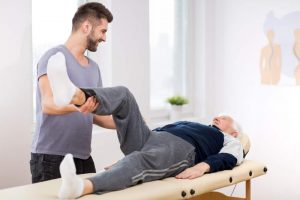Stroke management requires interdisciplinary expertise to provide the best outcomes for patients, from neurologists to physical medicine and rehabilitation physicians. It is because stroke that occurs due to blockage of blood vessels in the brain or cerebral hemorrhage may affect many other organs as brain is the center of nervous system. The golden period of stroke management must be carried on up to the time of therapeutic process for patients’ recovery. Bobath therapy is a type of therapy that can be applied in the recovery.
Getting to Know Bobath Therapy
Movement disorders and impaired body function may reduce the quality of life. Among adults, stroke is the leading cause for the disorders and impairments. Stroke patients often lose the ability to maintain balance in activities and movement of various parts of their bodies are limited, especially the hands and feet. For example, stroke patients cannot hold a pencil, wear their own clothes, and even get out of their own bed. In stroke treatment, Bobath therapy may be used to quell these problems.
Bobath therapy is a therapeutic concept proposed by physiotherapist Berta Bobath and psychiatrist/neurologist Karel Bobath that initially focused on patients with central nervous system problems, especially children with cerebral palsy. Through this therapy, the patients are reoriented so they can restore their movements.
Strokes that weaken the muscles in certain parts of the body is one of several factors that cause paralysis. Therefore, not only for cerebral palsy patients, Bobath therapy can also be applied to treat strokes and other neurological problems, such as Parkinson’s disease, spinal cord injuries, and head injuries.
Bobath therapy is also often referred to as neurodevelopmental treatment (NDT). Stroke patients have a limited ability to move without assistance. So, during a stroke treatment with Bobath therapy, the patients will be guided to gradually and repeatedly relearn certain movements until a normal pattern is formed. Patients are taught to learn each particular movement before moving on to another.
The more exercises the patients do, the more movement patterns are formed so their overall body function will improve. Bobath therapy aims to prevent patients from developing their own abnormal movement patterns. When the normal patterns have been acquired, the patients are expected to be more able to perform daily activities so their quality of life is maintained.
The Research on Bobath Therapy
Research on Bobath therapy has been carried out extensively since this method was discovered in the 1940s. However, despite the long-standing use of Bobath concept in therapy to improve postural reflex mechanisms and the function of limbs after stroke, its effect on patients is said to be unclear.
For example, a study titled “The Efficacy of the Bobath Concept in Stroke Rehabilitation” published in AHA Journals on January 29, 2009. The research of 16 studies involving 813 stroke patients found no benefit of the Bobath concept compared to other therapeutic methods. However, there is limited evidence that suggest there is an improvement in balance control.
Another study, “The Bobath Concept (NDT) as Rehabilitation in Stroke Patients” published in the November 2021 issue of the Journal of Family Medicine and Primary Care, also found no documentation explaining the effectiveness of Bobath therapy for strokes in comparison with other neurophysiotherapy techniques.
Nevertheless, another study, “The Effect of the Bobath Therapy Program on Upper Extremity and Hand Function in People with Chronic Stroke with Moderate to Severe Deficits” published in the November 2019 issue of the International Journal of Therapy and Rehabilitation, found that the application of Bobath therapy in stroke treatment for 6 weeks could improve upper limb function and reduce disability in moderate to severe chronic stroke patients.
Bobath Therapy Procedure
The form of stroke treatment with Bobath therapy depends on the condition of each patient. The medical team will use examination results that identify the impact of strokes experienced by the patients as a basis to determine the therapy program. Training patients to learn certain movement patterns according to their needs is the core of this therapy.
Therefore, the medical team will first review the patients’ condition to understand the limitations of movement they suffered due to the stroke. Generally, there are three methods used in Bobath therapy, namely facilitation, stimulation, and stabilization.
In facilitation, the patients are guided to master the movement patterns required to do something. For example, sitting up after lying on the bed. Patients will be taught how to control posture from lying down to being able to sit perfectly.
Stimulation is a stimulus given verbally or non-verbally to the patients when practicing movements. For example, the therapist gives verbal stimulation in the form of a signal. While non-verbal stimulation includes clapping or pressure on the patients’ body parts being trained. Meanwhile, stabilization is a method of achieving balance so the movement is more stable.
Who Can Perform the Bobath Therapy?
Stroke management with Bobath therapy can only be performed by trained personnel such as medical rehabilitation physicians, physical therapists, occupational therapists, and speech-language pathologists. The therapists who have completed the training are able to properly assess and treat various motor neuron problems experienced by patients.
Bobath therapists require collaborative work with patients, their families, and caregivers, as well as primary care physicians and other members of the rehabilitation team to develop and implement a comprehensive care program for each patient. The Bobath concept itself has undergone several developments to make its scope broader.
Bobath Therapy at Home
Bobath therapy can be performed at the patients’ home with a presence of a therapist. But they must first undergo an examination to determine the appropriate therapy program. From the initial therapy, they can learn movement patterns taught by the therapists and then practice by themselves. In the interest of successful stroke management, patients are not recommended to try Bobath therapy without prior training. The therapists may apply the Bobath concept with other therapeutic methods to achieve better results for the patients’ recovery.



